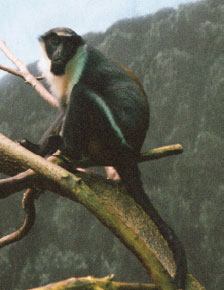The average body mass for an adult male Diana monkey is around 5 kilograms, and for the female it is around 4 kilograms. The facial pelage (hair) color is black and is surrounded by a white beard. The canines of this species shows sexual dimorphism. This species has cheek pouches to carry food in will it forages.
RANGE:
The Diana monkey is found in the countries of Ghana, Guinea, Ivory Coast, Liberia, and Sierra Leone. This species is primarily found in primary and secondary forests. The Diana monkey lives in the upper canopy of the forest (Estes, 1991).



